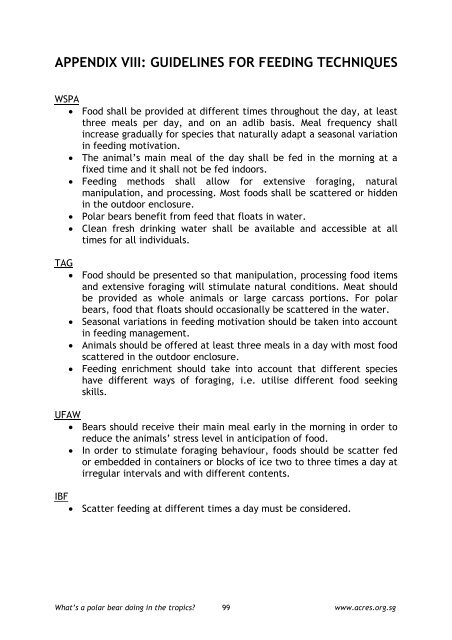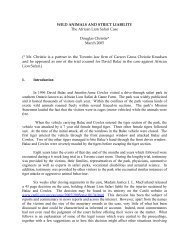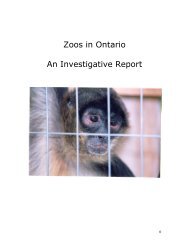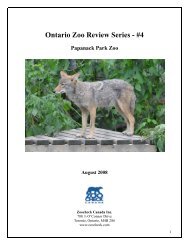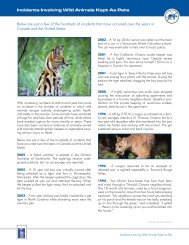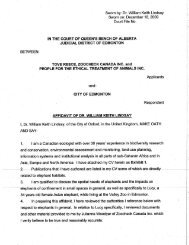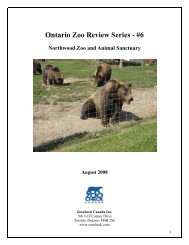What's a Polar Bear Doing in the Tropics? - Animal Concerns ...
What's a Polar Bear Doing in the Tropics? - Animal Concerns ...
What's a Polar Bear Doing in the Tropics? - Animal Concerns ...
Create successful ePaper yourself
Turn your PDF publications into a flip-book with our unique Google optimized e-Paper software.
APPENDIX VIII: GUIDELINES FOR FEEDING TECHNIQUESWSPA• Food shall be provided at different times throughout <strong>the</strong> day, at leastthree meals per day, and on an adlib basis. Meal frequency shall<strong>in</strong>crease gradually for species that naturally adapt a seasonal variation<strong>in</strong> feed<strong>in</strong>g motivation.• The animal’s ma<strong>in</strong> meal of <strong>the</strong> day shall be fed <strong>in</strong> <strong>the</strong> morn<strong>in</strong>g at afixed time and it shall not be fed <strong>in</strong>doors.• Feed<strong>in</strong>g methods shall allow for extensive forag<strong>in</strong>g, naturalmanipulation, and process<strong>in</strong>g. Most foods shall be scattered or hidden<strong>in</strong> <strong>the</strong> outdoor enclosure.• <strong>Polar</strong> bears benefit from feed that floats <strong>in</strong> water.• Clean fresh dr<strong>in</strong>k<strong>in</strong>g water shall be available and accessible at alltimes for all <strong>in</strong>dividuals.TAG• Food should be presented so that manipulation, process<strong>in</strong>g food itemsand extensive forag<strong>in</strong>g will stimulate natural conditions. Meat shouldbe provided as whole animals or large carcass portions. For polarbears, food that floats should occasionally be scattered <strong>in</strong> <strong>the</strong> water.• Seasonal variations <strong>in</strong> feed<strong>in</strong>g motivation should be taken <strong>in</strong>to account<strong>in</strong> feed<strong>in</strong>g management.• <strong>Animal</strong>s should be offered at least three meals <strong>in</strong> a day with most foodscattered <strong>in</strong> <strong>the</strong> outdoor enclosure.• Feed<strong>in</strong>g enrichment should take <strong>in</strong>to account that different specieshave different ways of forag<strong>in</strong>g, i.e. utilise different food seek<strong>in</strong>gskills.UFAW• <strong>Bear</strong>s should receive <strong>the</strong>ir ma<strong>in</strong> meal early <strong>in</strong> <strong>the</strong> morn<strong>in</strong>g <strong>in</strong> order toreduce <strong>the</strong> animals’ stress level <strong>in</strong> anticipation of food.• In order to stimulate forag<strong>in</strong>g behaviour, foods should be scatter fedor embedded <strong>in</strong> conta<strong>in</strong>ers or blocks of ice two to three times a day atirregular <strong>in</strong>tervals and with different contents.IBF• Scatter feed<strong>in</strong>g at different times a day must be considered.What’s a polar bear do<strong>in</strong>g <strong>in</strong> <strong>the</strong> tropics?99www.acres.org.sg


